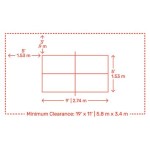Essential Aspects of Patio Vegetable Garden Designs
Transform your patio into an edible oasis with a well-designed vegetable garden. These essential aspects will guide you towards a thriving and aesthetically pleasing outdoor space.
1. Container Selection
Choose containers suitable for the size and type of vegetables you intend to grow. Consider materials like terracotta, plastic, or raised beds. Ensure they have adequate drainage holes to prevent waterlogging.
2. Plant Selection
Select vegetables that thrive in containers and are suitable for your climate. Consider space-saving vertical plants like tomatoes, cucumbers, and beans. Also include herbs, such as basil, parsley, and chives, for flavor and companionship.
3. Soil
Use a high-quality potting mix specifically designed for container gardening. Amend the soil with organic matter like compost or manure to improve drainage and fertility.
4. Watering and Fertilizing
Water regularly, especially during hot and dry weather. Allow the soil to dry out slightly between waterings. Fertilize monthly with a balanced liquid fertilizer to provide essential nutrients.
5. Sun and Shade
Most vegetables require full sun, but some can tolerate partial shade. Consider the location of your patio and choose plants that match its light conditions. Provide supplemental lighting if necessary.
6. Trellising and Support
Vertical plants need support to grow upright and prevent overcrowding. Use trellises, stakes, or cages to guide their growth and maximize space utilization.
7. Aesthetics
Incorporate a mix of plants with different textures, colors, and heights to create visual interest. Consider using companion planting to improve growth and deter pests. Add decorative elements like wind chimes or bird feeders to enhance the ambiance.
8. Placement and Accessibility
Position your patio garden strategically for convenience and aesthetics. Ensure easy access for watering, harvesting, and maintenance. Consider raised beds for improved accessibility and drainage.
9. Pest and Disease Management
Regularly inspect your plants for pests and diseases. Use organic pest control methods like companion planting, neem oil, or insecticidal soap. Remove infected leaves or plants promptly.
10. Succession Planting
Maximize your harvest by succession planting. Plant different varieties or stagger planting times of the same vegetable to extend the growing season and ensure a continuous supply of fresh produce.
Conclusion
By incorporating these essential aspects into your patio vegetable garden design, you can create a thriving and visually appealing outdoor space. Enjoy the benefits of fresh, homegrown produce, enhance your patio's ambiance, and cultivate a sense of well-being and connection with nature.

How You Can Start A Balcony Garden

Patio Vegetable Garden Setup And Tips To Get Growing

25 Best Vegetable Garden Layout Ideas For Your Yard

Quickstart Guide To Container Vegetable Gardening Lovely Greens

Small Vegetable Garden Ideas Gate

22 Stunning Container Vegetable Garden Design Ideas Tips Herb Containers

35 Creative Container Vegetable Garden Ideas A Piece Of Rainbow

Patio Vegetable Garden Setup And Tips To Get Growing

22 Practical Patio Vegetable Garden Ideas Balcony Web

35 Creative Container Vegetable Garden Ideas A Piece Of Rainbow








